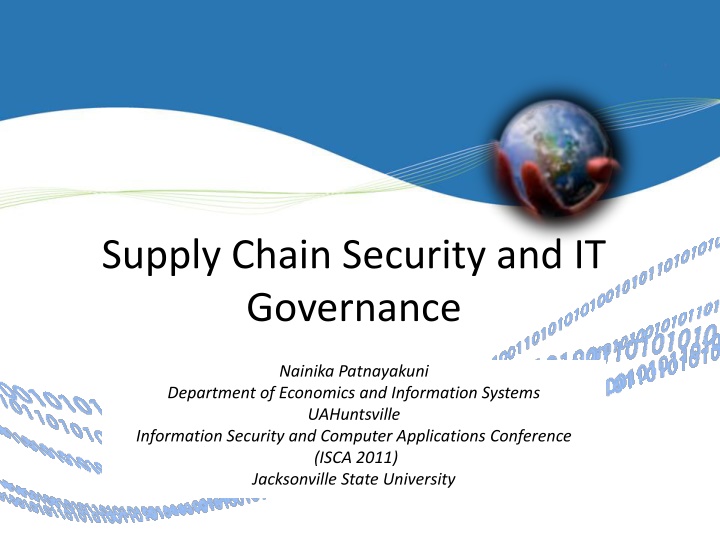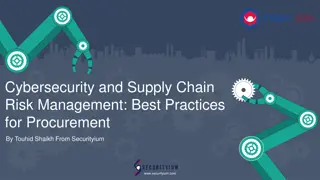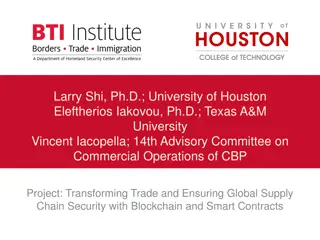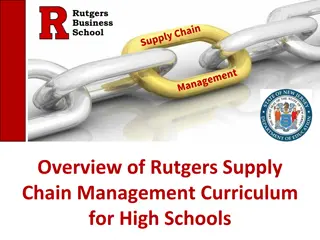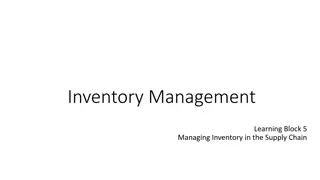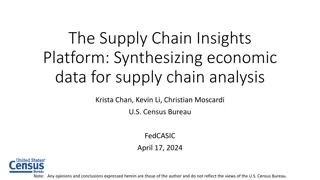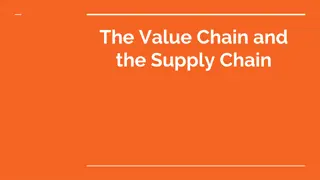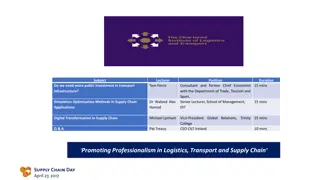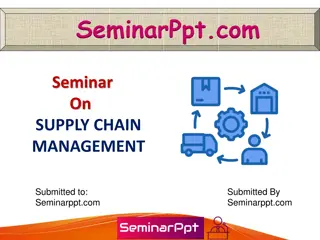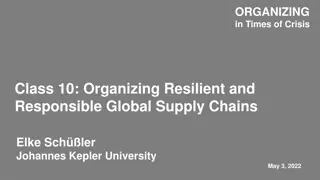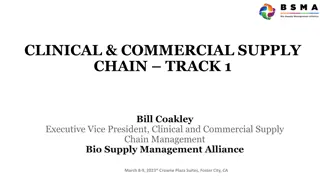Enhancing Supply Chain Security and IT Governance: An Overview
This presentation delves into the critical aspects of supply chain security and IT governance, highlighting the synchronization of IT decisions across supply chains, global supply chain concerns, the cost implications of supply chain security lapses, and the need for more research and strategic alignment in this area. It emphasizes the significance of safeguarding supply chain assets from theft, damage, terrorism, and unauthorized activities, offering insights into developing organizational capabilities and investing in technologies for enhanced security.
Download Presentation

Please find below an Image/Link to download the presentation.
The content on the website is provided AS IS for your information and personal use only. It may not be sold, licensed, or shared on other websites without obtaining consent from the author.If you encounter any issues during the download, it is possible that the publisher has removed the file from their server.
You are allowed to download the files provided on this website for personal or commercial use, subject to the condition that they are used lawfully. All files are the property of their respective owners.
The content on the website is provided AS IS for your information and personal use only. It may not be sold, licensed, or shared on other websites without obtaining consent from the author.
E N D
Presentation Transcript
Supply Chain Security and IT Governance Nainika Patnayakuni Department of Economics and Information Systems UAHuntsville Information Security and Computer Applications Conference (ISCA 2011) Jacksonville State University
Research Questions How are IT related decisions synchronized across the supply chain? Does this differ across different types of supply chains?
Presentation Overview Supply Chain Security Research IT Governance Research Types of Global Supply chains Development of Conceptual Framework Future Research
Supply Chain Security Concerns Global supply chains are now a part of the war on terror If a supply chain lets a weapon of mass destruction be shipped by container, it will cost the supply chain about $1 trillion (Eggers, 2004). The delays at the USA and Canadian border cost well over $8 billion a year (Burke, 2005). Focus has shifted from things taken out to things put in
Why Study? Supply chain security is expensive -Increase in freight and insurance rates -32% between 2001 and 2004 (Lee 2004, Hannon 2002) Organizations remain vulnerable Not enough research on Inter-organizational aspects, especially IT (Croteau and Bergeron 2009) Does not connect supply chain security to organizational strategies and supply chain types
Security Research Overview Partnerships with government Supply chain planning Partnerships with suppliers, customers and competitors Developing organizational capabilities Investment in technologies
Defining Supply Chain Security Application of policies, procedures, and technology to protect supply chain assets Closs and McGarrell (2004, p. 8) from theft, damage, or terrorism, and to prevent the unauthorized introduction of contraband, people, or weapons of mass destruction into the supply chain.
Partnerships with Government Partnerships with government agencies has exploded Examples Advanced Manifest Rule (AMR) 2003 cargo data needs to be provided to US Customs 24 hours prior to loading containers to a US-bound ship Customs-Trade Partnership Against Terrorism (C-TPAT) certification based on security practices for expedited US entry Container Security Initiative (CSI)-pushing inspections and container to upstream and loading ports
Supply Chain Planning Supply Chain Continuity Planning is a part of business continuity planning (Zsidisin et al. 2005) but plans are not comprehensive IT related continuity planning has focused on organizational IT rather than inter- organizational IT
Partnering Unaware of what partners are doing for security (Ritter et al., 2007) Partnering with competitors (Sawhney and Sumukadas, 2005 Sharing some information with some people (Closs and McGarrell 2004) Is this one size fits all?
Investments in Technology RFID for supply chain visibility Investing in backups and information security (Prokop 2004, Helferich and Cook 2002) GPS tracking and reporting How to ensure that the partners are investing in firewalls, anti-virus, encryption programs and information security policies?
Organizational Capabilities Communication and information sharing: Security and Logistics work like silos (Helferich and Cook 2002) Inventory risk mitigation strategies such as buffering(Knight 2003) Process standardization (Sheffi 2005) Linking security to rewards (Quinn 2003) IT governance and organizational security capabilities?
IT Governance Focuses on who makes IT decisions and how(Weill 2004) It is about the locus of control of IT decisions related to infrastructure, use, project management, standards etc(Sambamurthy and Zmud 1999, Peterson et. al 2000)
Centralization Decentralization Debate Centralization leads to specialization, Scale economies, standardization and increased risk (Peterson 2004) Decentralization leads to flexibility but variance in standards Conclusion most organizations have a federal model where they centralize infrastructure decisions and decentralize business application decisions
IT Governance Research Centralization debate only focuses on where decisions are made Most organizations have federal models How to we integrate federal IT decisions in supply chains?
Integrating Global IT Decisions Structural integration-liaison roles and teams Process integration aka Formalization, standardization and codification Relational integration-consensus, persuasion and common learning (Peterson 2004)
Integrating Security Decisions Structural integration Institutionalized teams with suppliers to make decisions related to IT infrastructure and security Committees and inter-organizational liaison roles Process integration Partnering with suppliers to enforce standards Working with Government to ensure CTPAT rules are formalized and imposed through IT systems Formalizing a disaster recovery plan for all supply chain partners Relational integration Joint training of with supplier staff for IT related risks Inter-organizational reward systems that emphasize security awareness Collocation and frequent communication
Types of Supply Chains (Gereffi, Humphrey and Sturgeon 2005)
Implications Locus of control for IT governance decisions is likely to be decentralized to supply chain partners for market and modular supply chains Main sources of integration is the formalization and codification of security related rules at points of handoffs In market based exchange, if relationships are transitory formalization may be minimal
Implications For Relational supply chains Locus of control for security decisions will be shared Informal, trust and shared understanding governance based mechanisms should be used for IT governance decisions and they would also rely on structural means of integration such as cross functional teams
Implications For Captive Supply chains The focal organization can enforce security decisions Process standardization and formalization can be imposed for IT governance
Implications For hierarchies The LOC is centralized in the focal firm Structural and relational integration mechanisms can be used for integration (common understanding and team based functions) The necessity for codification and standardization of every aspect of governance and security decision making is likely to be lower than in hands-off relationships
Conceptual Framework Supply Chain Type Locus of Control Structural Integration Process Integration Relational Integration Decentralized Low Market High Low Decentralized Low Modular Relational High Low Low High Shared High Centralized Captive Low High Low Centralized Hierarchy High Low High
Research Direction Identify and analyze case studies that provide examples of how the LOC and governance of these decisions varies across different types of supply chains
Supply Chain IT Governance Decisions IT infrastructure integration Use of client server, EDI security, Interoperable infrastructure Application Integration Use of middleware, XML, web services and security of interconnected processes Data integration Integrating RFID and security data, common data definitions
